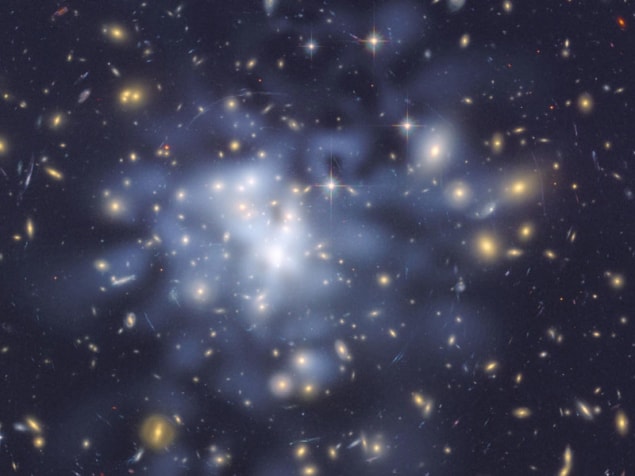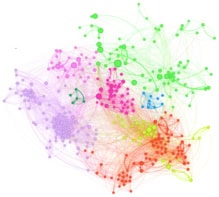
New findings from the CoGeNT experiment in the US add strength to the claims of a group in Italy that has been saying for over a decade that it has detected dark matter.
More than 80% of the mass in the universe is believed to be accounted for by dark matter. But while the substance appears to have a strong gravitational influence on the motion of galaxies, it does not interact with light and has proven very difficult to detect directly – let alone study in any detail. The favoured candidate for a dark-matter particle is known as a “weakly interacting massive particle”, or WIMP for short. Various experiments have been constructed to detect WIMPs by looking to see if they interact with highly sensitive detectors.
Researchers at one of these experiments, the DAMA/LIBRA detector at the Gran Sasso National Laboratories in central Italy, stand apart from the rest of the dark-matter community. That is because they have been claiming for years that they have successfully detected dark matter. Rather than looking for individual WIMPs, the DAMA/LIBRA experiment is designed to look for variations over the course of a year in the interactions between dark-matter particles and the sodium iodine crystals inside their detector. The researchers say they have observed an annual oscillation in detections for the past 13 years, which they believe is caused by Earth’s motion through dark matter.
DAMA/LIBRA explains the oscillation by saying that, during the summer, the Earth is moving into the rest frame of a halo of dark matter that surrounds the Milky Way, which causes the number of interactions to peak. Then, in the winter, the Earth is moving away from this rest frame, causing the signal to drop off. The situation is analogous to a car driving through a rainstorm where more raindrops hit the front windshield than the back one.
A sceptical community
But while few in the dark-matter community deny the existence of modulation, many researchers have remained sceptical of the DAMA/LIBRA claims, and to date no other detector has managed to repeat the findings. Among the sceptics is Juan Collar, a member of the CoGeNT collaboration. CoGeNT is a relatively small dark-matter detector located in the Soudan Mine in northern Minnesota, which uses a germanium target to look for low-mass WIMPs. Indeed, Collar’s collaboration set out to test the DAMA/LIBRA claims by looking for an oscillation in 15 months of data. “I thought we were going to blow the DAMA claims out of the water,” Collar told physicsworld.com.
I thought we were going to blow the DAMA claims out of the water Juan Collar, CoGeNT collaboration
But to Collar’s surprise, CoGeNT’s findings appear to corroborate the DAMA/LIBRA data. They reveal a seasonal modulation consistent with the presence of WIMPs with masses of 7 GeV/c2. Detailing their findings in a paper submitted to arXiv, Collar and colleagues say that their results are reliable to a statistical significance of 2.8 sigma. In everyday terms, this means there is just a 0.6% chance that the result is a statistical fluke.
Collar says that his collaboration is still “as critical of DAMA as anyone else” over the claim that the seasonal modulation must be dark matter. But he admits that he cannot yet explain what could be causing the seasonal modulation. He says that his team was careful to exclude other possible sources that could have caused a modulation in the signal, such as seasonal variations in the flux of muons passing through the atmosphere, or radon emerging from rocks surrounding the detector.
Dan Hooper, a theorist based at Fermilab in the US, says that he is “very excited” about the CoGeNT results. “In all of the ways I have studied the data, they look like what you would expect to see from dark matter,” he says. “I suspect that these results will cause some scientists to reconsider the long-claimed DAMA/LIBRA signal”. Hooper warns, though, that the collaboration will need more data to rule out the possibility that the signal is purely due to chance.
Lucky escape from the fire
Indeed, Hooper was pleased to tell physicsworld.com that the CoGeNT team had commenced a fresh run a data collection last Monday (6 June). There had been concern that the detector had undergone damage following a fire in the Soudan Mine in March.
But other researchers have been more sceptical of the CoGeNT collaboration from its outset. Researchers at the XENON 100 experiment in Italy, for instance, claim that they have already ruled out the possibility of WIMPs existing within the mass range that CoGeNT is designed to consider. The XENON 100 is a liquid-xenon-based detector considered by many to be the most sophisticated experiment designed for direct dark-matter searches.
However, both Collar and Hooper believe that there are reasons to believe that a light-mass dark-matter particle could have escaped detection by XENON 100. In a separate paper submitted to arXiv, Collar questions the sensitivities of the XENON 100 detector and its predecessor, XENON 10. Collar proposes that the XENON teams have made far too many assumptions in excluding low-mass WIMPs. “XENON is tremendously biased,” he told physicsworld.com.
The debate, however, is likely to go on. Henrique Araujo, a dark-matter researcher at Imperial College London remains open to the idea that CoGeNT has seen dark matter but he expects that other detectors should have seen the CoGeNT signal. “Bearing in mind that CoGeNT has a very small target mass of 440 g and that it actually claims to see quite a large total number of ‘light WIMP’ events, other detectors should find plenty of recoils creeping up at the energy threshold,” he said.




